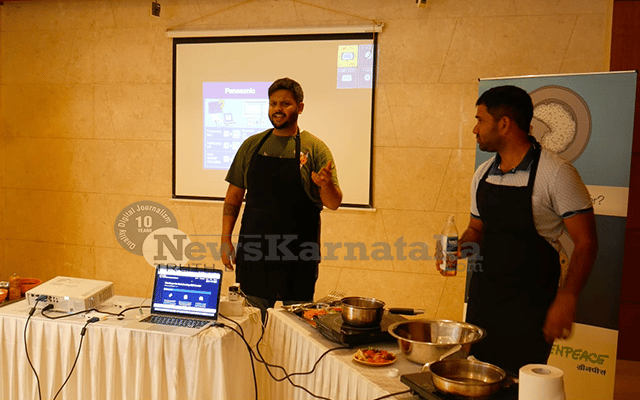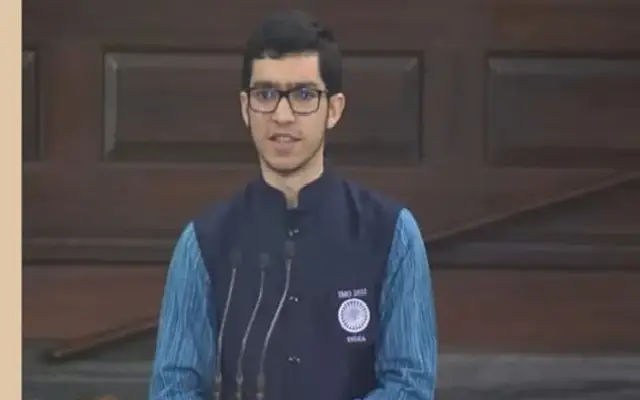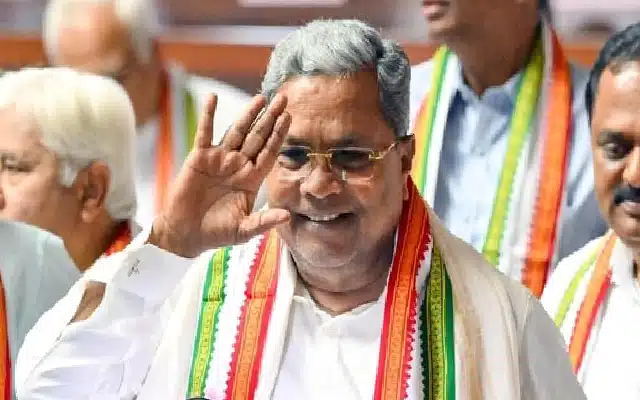Bengaluru: On the afternoon of Sunday November 20, Greenpeace India hosted Cooking Up Change – Rediscovering Our Forgotten Rice, a chef’s table that celebrated dietary diversity and indigenous food as a means to build community resilience to climate change and fight malnutrition. The event was held at RMZ Galleria in Yelahanka, Bengaluru.
While there is a considerable degree of excitement and concern among the public with regard to eating healthy and chemical-free food, indigenous food varieties remain untapped on a large scale. There are several reasons for this such as lack of good information, general apprehension and misinformation to name a few.
To change this, Cooking Up Change brought a culinary experience of India’s rich rice heritage and its unique flavours by hosting an organic food pop-up along with a short demo cook-along that explored ways to cook indigenous rice varieties. Chef Rutwik Khasnis and Chef Vikas Prithvinath from Greenpeace India used local, delicious, aromatic, sustainable and healthy rice varieties such as Njavara, Gandhakashala, Valiachennellu and Mullankaima to whip up tasty dishes. The event also included an exhibition-cum-sale of organic rice varieties by farmers.
Rutwik Ajit Khasnis, Campaigner at Greenpeace India, commented, “Our focus is on urban consumers as they have the power to create new market patterns and change the way we look at nutrition. Organic farmers and FPOs are a key part of this process and they are leading from the front in our fight to build sustainable indigenous food systems which can meet the nutritional requirements of all citizens.”
The meals prepared by the participants at the event were entirely sourced from organic farmers. One of the chefs, Ms. Pushpa Blessings made idlis using two varieties of rice, a semi-boiled rice called Wayanad Tondi and an unpolished variety called Chendali, both indigenous to Wayanad in Kerala. Chayan, a young boy still in high school, prepared a biryani using a fragrant rice variety called Gandhasaale sourced from Mandya District. Another chef, Priya, decided to give Bisibele bath, the beloved dish of Bengaluru, a healthy twist, by making it with little millet (gondhli) with the addition of over eight vegetables including certain lost or “orphaned” varieties such as air potato.
Rashmi B. Suny, an attendee at the event, spoke about their experience, “I had no idea our local rice varieties are so tasty. I love rice and we consume it every day. Looking at these dishes, I am now seriously considering getting my local rice directly from the farmers. If I can fight climate change while eating a delicious, healthy and safe meal, then what more can I ask for!”
Rediscovered rice varieties
Rice is a widely consumed cereal grain in India and a staple in the subcontinent. India is the second largest producer of this crop, which is considered a key pillar of its food security. Studies have shown that several traditional varieties of rice cultivated in India possess nutritional and medicinal values and can treat many diseases. Though India cultivated more than one lakh varieties of rice before the green revolution, now only 6,000 varieties of rice survive. Among them, the following varieties were used at the chef’s table:
1. Njavara is a popular medicinal red rice of Kerala used in ayurvedic medicines.
2. Gandhakashala is an aromatic, small, bold, white rice, native to Wayanad and considered the soul of Malabar biriyani.
3. Valiachennellu is a medicinal rice and rich in iron. Thus, traditionally, this full-bran rice is given to pregnant women and lactating mothers. It is also useful in alleviating anemic conditions.
4. Mullankaima is considered good for children as it contains very high Vitamin A content.
Through this event, Greenpeace India aims at developing and strengthening consumer-producer linkages through Community Supported Agriculture (CSA). This process connects farmers directly with consumers for the purchase of naturally grown produce and eases marketing activities by forming consumer collectives – self-formed groups created out of resident welfare associations or local community centers to facilitate easy shipping. By promoting a direct link between the organic farming community and consumers, the joys and burdens of natural farming can be shared with consumers, which will further make the organic market accessible to all.

















